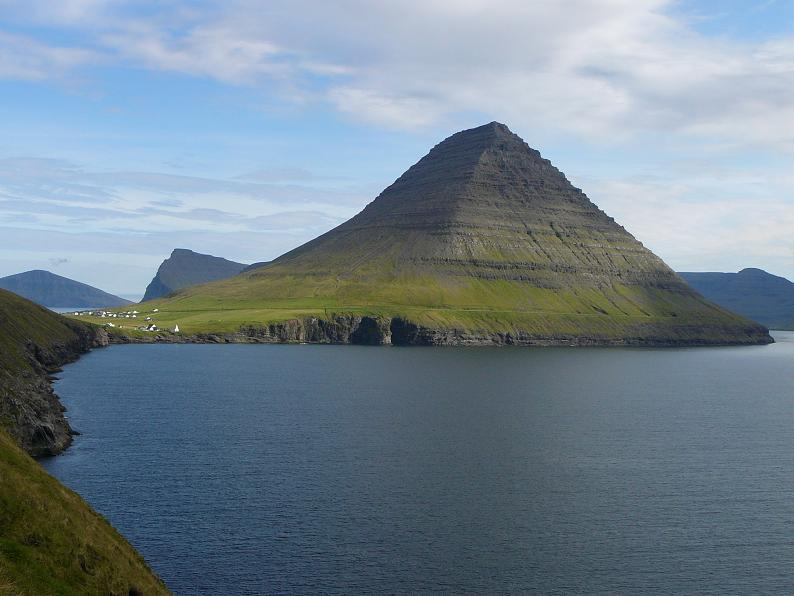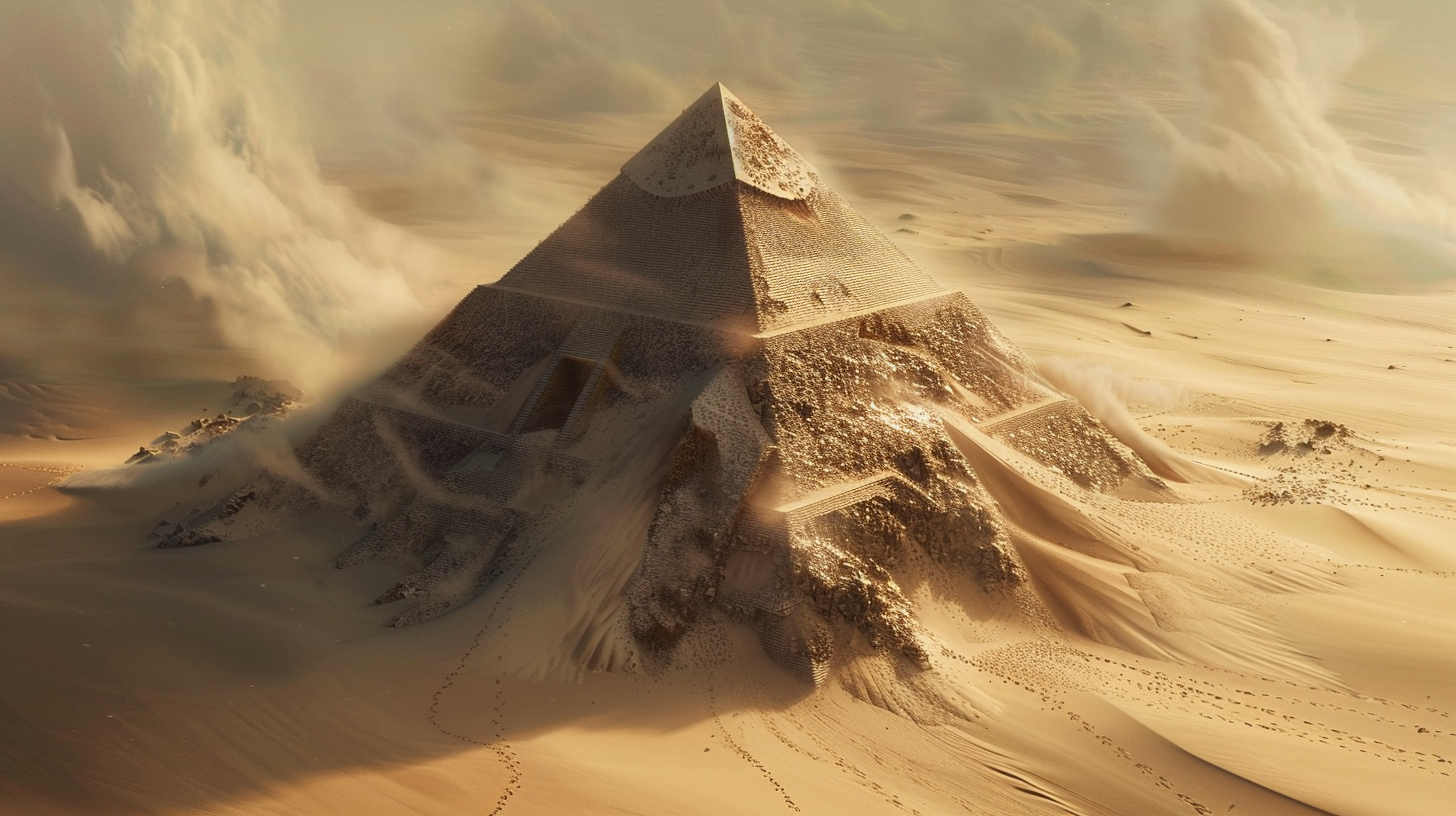The Faroe Island Pyramids
When you hear about the Faroe Island Pyramids, your mind probably doesn‘t wander to ancient civilizations and man-made structures. From what we know, these natural formations are the result of millions of years of volcanic activity and the relentless forces of erosion. They’re not just singular formations, but a series of peaks sprinkled across the Faroe Islands, contributing to the archipelago’s dramatic skyline.
But…among these natural wonders, a peculiar formation stands out: the pyramid-like mountain known as Kirvi.
This structure has sparked a fascinating debate about its origins. Officially a natural formation, however some suggest it may not be a mere whimsy of nature but rather a man-made structure with very ancient roots.
Origins of the Pyramids
The geological existence of the Faroe Island Pyramids extends back over 50 million years. The story behind their formation is fascinating.
The pyramids are primarily framed by layers of basaltic lava. These layers solidified and folded to attain their present-day sharp angles. The relentless North Atlantic climate played a significant role as well; carving out valleys and refining peaks.
Far from being human-made structures, these pyramids are purely the product of time and elemental forces. Advanced radiometric dating methods suggest that these mountains formed during the Paleogene period, over 60 million years ago. This was when the area experienced extensive volcanic activity, shaping the archipelago into what it is today.
The Mystery of Kirvi
As natural wonders often do, the Faroe Island Pyramids have a way of inspiring local folklore and legends. Steeped in centuries-old history, these pyramids often find themselves at the center of tales featuring giants and other mythical beings. One in particular gets a lot of attention.
Kirvi, towering at 236 meters, is an imposing sight on the island of Suðuroy. Its remarkably symmetrical shape, reminiscent of a pyramid, sets it apart from the surrounding landscape.
Despite its striking appearance, there is scant historical documentation to shed light on its origins, leaving much to speculation and investigation. I mean it does look eerily like an ancient pyramid doesn’t it?

Arguments for Man-Made Origins
The theory that the Faroe Island Pyramid is man-made is supported by some observations and interpretations, despite the general consensus that these are natural formations.
Unnatural Precision
One of the most compelling arguments for Kirvi’s man-made origins is the geometric precision of its shape. There are “no straight lines in nature” as you’ve no doubt heard before.
Unlike the random, chaotic forms typically produced by natural processes, Kirvi’s pyramid-like structure portrays a level of planning and execution that one could say is distinctly human. The peak, the even 4 sides, the straight lines. This precision, seen in other ancient man-made structures, challenges the notion that Kirvi could have formed naturally as those 3 aspects are telltale signs of engineering.
Ley Lines and Geographical Alignments
The theory of ley lines, invisible lines connecting ancient sites across the globe, adds another layer of intrigue to Kirvi’s origins.
Some researchers propose that Kirvi aligns with other ancient structures, hinting at an intentional placement that transcends mere coincidence. This alignment, if proven, could indicate a sophisticated understanding of geography and astronomy by the pyramid’s builders.
Arguments for Natural Formation
Geological Processes
The Faroe Islands are the result of volcanic activity millions of years ago, and their rugged landscape has been shaped by the relentless forces of nature. The symmetrical shape of Kirvi, while unusual, can be explained by the natural processes of erosion and the unique geological composition of the area. Basaltic layers, common in volcanic landscapes, can form steep, angular formations that resemble man-made structures.
Similar Natural Formations
Across the globe, there are numerous examples of natural formations that bear a striking resemblance to man-made structures. The Giant’s Causeway in Northern Ireland and the hexagonal columns of Devil’s Postpile in California are just two examples of how nature can create geometrically precise shapes without human intervention. These examples provide a context for understanding how Kirvi could have formed naturally.
Lack of Human Evidence
Despite extensive investigations, there has been no conclusive evidence of human activity associated with the formation of Kirvi. Unlike true ancient pyramids, which are often surrounded by artifacts, tombs, and other signs of human presence, Kirvi lacks these hallmarks of construction. This absence of evidence is a strong indicator of its natural origins.
Scientific Consensus
The scientific community, including geologists and archaeologists, largely supports the theory of natural formation for Kirvi and similar structures in the Faroe Islands. Studies of the island’s geology and the formation’s characteristics have not revealed any signs that point to human engineering or modification.
Public Perception and Interest
The Faroe Island pyramids have captured the public’s imagination, featuring prominently in media and online discussions. This fascination has spawned a range of theories, from the plausible to the fantastical.
While some eagerly embrace the idea of ancient, high-tech civilizations, others caution against veering too far from scientific rigor.
Conclusion
Whether natural or man-made, this region reminds us of the wonders that await discovery in the most unexpected of places.
References and Further Reading
For those intrigued by the mystery of the Faroe Island pyramids, check out some of these resources:
- Fact-checking and analysis of the Faroe Islands pyramid claims: AFP Fact Check
- Discussion on the natural vs. man-made debate: The Brain Chamber – Faroe Island Pyramids
- Social media and public perception: Ancient Explorers on Facebook





